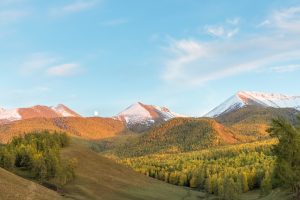When “Winter Pasture” was first published in 2012, the travel memoir became a literary sensation in China. Set in the Altay region of Xinjiang, the book describes a herding family’s journey into the wilderness for one eventful season. Along with memorable vignettes of steppe life, author Li Juan offers a rare inside look at Xinjiang’s other beleaguered ethnic minority: the Kazakhs. The long-awaited English translation was released earlier this year, and it doesn’t disappoint.
In the winter of 2010, the author accompanied a group of Kazakh herders to a bleak scrubland south of the Ulungur river. The trip was likely the family’s final expedition to the winter pasture. Li counts herself fortunate to have “witnessed the last hurrah” of a dying tradition.
China introduced a new land conservation policy in 2003 to discourage the millennia-old practice of nomadic herding in the west. Known as tuimu huancao (converting pastures to grasslands), the project was part of an ambitious campaign to “Open up the West” for economic development. In a 2005 speech, Chinese Premier Wen Jiabao said 60 percent of the rural poor lived in the western region and toiled on depleted, overgrazed lands. Rejuvenating the grasslands, which accounted for 90 percent of new desertification, became a priority for policymakers.
“So, where did it all go wrong?” Li wonders how a natural cycle that connected sheep and pasture had irretrievably broken down. After all, she muses, herders were the guardians of the grasslands. Without their flock, “the grass seeds that drift onto the earth in autumn will no longer feel the force of stomping hooves that bury them deep into the soil. The masses of manure that fertilized their growth will no longer fall on them.” She gently pushes back on the official narrative that overgrazing by herders was killing the grasslands.
A few chapters into the book, Li hints that the government may have bigger plans for the Kazakh grazing grounds. When she spots a metal fence that extends far into the horizon, her host Cuma speculates that the pasture was being turned into a prairie national park to attract tourists. Another telling sign: a tall steel tripod atop a sand dune. Was there oil under the scrubland? Cuma was not hopeful about the money materializing in his lifetime, even if they did strike oil. The message to the herders was clear: get off the land.
While Li Juan laments the passing of a traditional way of life, she is clear-eyed about the hardships involved. The physical toll of a sheep-centric existence was staggering. After hauling slabs of frozen manure from the sheep pen one morning, the exhausted crew pops painkillers “like jelly beans.” Swallowing copious amounts of aspirin was part of the daily routine for adults, and every winter burrow was well stocked. Even teenagers had a weather-beaten appearance. Li observes that young Kama’s “rosy cheeks had turned deep red, and eventually into a soy sauce color.”
Herders spend the winter months holed up in underground burrows. Warmed by a stove and plastered with insulating sheep manure, the burrow was a haven of sorts but “whenever the dog walked over the roof, ash and dust fell into everyone’s tea bowls and onto the tablecloth.” Despite the constraints, families keep up with Kazakh traditions. Guests drop in (literally) for endless cups of tea. Women embroider felt rugs under solar-powered lamps. And every meal begins with a Muslim prayer.
Among the older generation, few spoke or understood Mandarin. Herders read Kazakh newspapers, sing Kazakh songs, and watch Kazakh TV. Families were large, seemingly in violation of China’s one-child policy. Even Kazakh dumplings were different, fish-shaped, and stuffed with chunks of horse meat. “Winter Pasture” is not an overtly political book, but these granular details from a Han Chinese writer speak volumes about the ethnic Kazakh’s tenuous place in contemporary China.
Li senses a growing disconnect between older Kazakhs and their children, who spend most of their time at state-run boarding schools. “Zhada was the son of a shepherd, so of course he loved the land, but what truly inspired him was the glittering life beyond the pastures,” she observes. Zhada’s true passion was electronics, and he dreamed of a future that didn’t involve sheep.
The brutal winter of 2009, when livestock perished in droves, forces the community to consider alternatives to nomadic life. One horse trader sums up his mixed emotions saying, “Of course settling is a good thing! But then Kazakh will be over!” Li sees the government’s plan to create pastures of “luxuriant grasses” grown with chemical fertilizer as ecologically flawed. But she admits that state subsidies would help Cuma purchase the car he long hoped to own.
“Winter Pasture” is no ordinary travel memoir. Li Juan tackles big themes like Kazakh identity, oil and mineral exploration in Xinjiang, climate change in the grasslands, and the rise of consumer culture in China through the prism of one family’s survival in the wilderness.
It has been close to a decade since the book was published. Today the grasslands are vacant. Herders have moved to settler villages, and grass seeds are scattered from up high by plane. In 2019, China permitted 2,000 citizens to migrate to Kazakhstan. Kazakh emigres, many of them herders, were among the first to inform the outside world about Xinjiang’s internment camps.

































